
ANTONY PRESTON, JOHN BATCHELOR
THE SUBMARINE SINCE 1919
Comparison of Russian Type 1A and "S" Class designs
| Comparison of Russian Type 1A and "S" Class designs | |||
| 1A | Gür | Stalinets | |
| Tonnage (surf/sub) | 862/983 | 750/960 | 780/1050 |
| Lenght (ft) | 237·5 | 237·5 | 256 |
| Beam (ft) | 20·25 | 20·3 | 21 |
| Draught (ft) | 14 | 13·5 | 13 |
| Machinery | 2800 bhp / 1000 chp | 2800 bhp / 1000 chp | 4200 bhp / 220 chp |
| Speed (surf/sub) (knots) | 17¾8¼ | 20/9 | 20/8,5 |
| Torpedo-tubs | 6x21-in 4b 2s | 6x21-in 4b 2s | 6x21-in 4b 2s |
| Guns | 1x4·1-in 1x20·1 mm | 1x4-in | 1x3-in 1x45-mm |
Nothing has been said so far of German developments, for of course Germany was not allowed to have U-Boats under the Treaty of Versailles. As we have seen, the German Navy made sure that it kept abreast of submarine developments: by financing design work in other countries. Thus when Hitler and his National Socialist government repudiated the Versailles Treaty and began rebuilding the armed forces in 1934. there was a great deal of expertise available.

French Casabianca. Thirty-one "1500-tonne" 1st Class submarines were built between 1924 and 1939 for overseas work. Most were scuttled, either at Brest in 1940 or at Toulon in 1942, but the Casabianca was able to make her escape from Toulon to join the Allies in North Africa. Later she distinguished herself in the liberation of Corsica by sinking a sub-chaser and damaging another. Displacement: 1,570 tons (surfaced) 2,084 tons (submerged). Length: 302 ft 9 in. Beam: 27 ft. Armament: Nine 21·7-in torpedo-tubes (4 forward, 3 and 2 aft); two 15·7-in torpedo-tubes (external aft); one 3·9-in gun; two 13·2-mm AA guns. Speed: 19 knots (surfaced), 10 knots (submerged)
Five basic types were considered; seagoing types of 500-750 tons, ocean-going boats of 1,000 tons, U-cruisers of 1,500 tons, and coastal submarines and minelayers of 250-500 tons. The sea-going type was based on the Turkish Gür which had been built in Spain to a pre-1934 German design, but the first coastal type was based on the UBII Type of the First World War. The ocean-going boats of Type IXA were based on the U117 or UEII Type of the First World War, particularly in having a much increased number of reload torpedoes.
Among, the many experimental ideas was one for a submarine carrying two small motor torpedo-boats on deck in cylindrical hangars. Like the operation of aircraft this was an idea which looked better on the drawing board than it did to an anxious U-Boat commander worrying about the length of time taken to get things in and out of hangars, and it was quietly dropped. Likewise the 2,500-ton minelayers of the Type XA and a trio of aircraft-carrying 3,000-ton U-cruisers were abandoned, no doubt with a sigh of relief from the submariners.
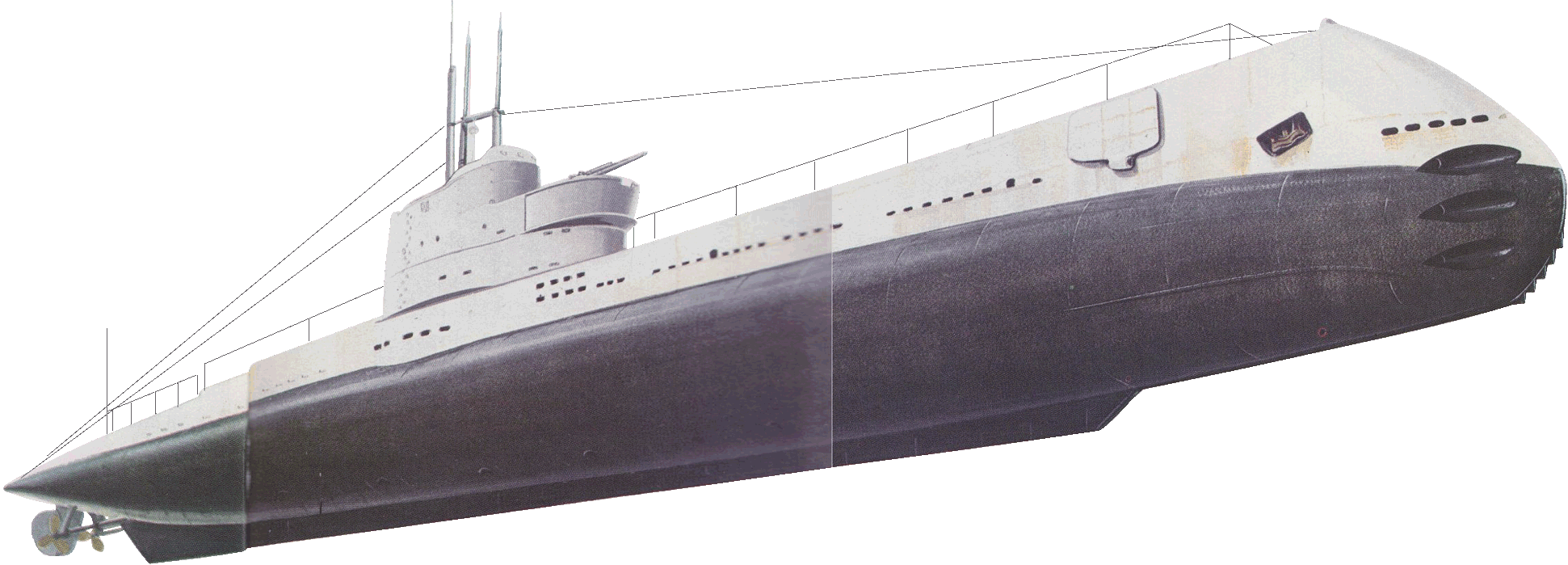
British Olympus. The success of the prototype Oberon led to the introduction of six "O" Class submarines in 1926 for service in the Far East. They were the first of a series of similar boats which incorporated the lessons of the recent war, and although quite successful they suffered from having external fuel tanks which leaked oil. This, combined with their size, led to four of the six being lost in the Mediterranean in 1940-42
The standard sea-going U-Boat which evolved from this series of prototypes was Type VII. The first group, known as VIIAs, Were developed from a German design built in Finland but in turn the Finnish boat owed a lot to the old UBIII Type of the First World War. U27 was the first to be launched in 1936, and by the outbreak of the Second World War the improved Type VIIB was in service. The Type VIIC which followed had many improvements over the original A type, such as more powerful diesel engines and greater fuel capacity, and became the standard wartime type. By 1941 the first had been launched, and as the 600-odd which were built came very close to winning the war for Hitler and Nazi Germany, a closer look is indicated.
The Type VIIC U-Boat had a waterline length of 220 ft, a beam of just over 20 ft. and displaced about 770 tons on the surface. She was of fairly conventional design, with saddle tanks, four bow tubes and two stern tubes; her diesels drove her at 17 knots on the surface and the electric motors could produce 7,5 knots for a limited time under water.

Russian "K" Class. This class was also known as the Katyusha Class, and they were large ocean-going submarines with a heavy armament. Displacement: 1,390 tons (surfaced). Armament: Ten or twelve 21-in torpedo-tubes; two 3·9-in guns; two 45-mm AA guns
Although not an ideal type for the Second World War as if turned out, the Type VII series was simple to build and very handy. Its principal drawback was its endurance, 6,500 miles at 12 knots, which proved insufficient for extended operations, while its lack of internal space imposed extra burdens on personnel. British submariners would have been surprised to learn that their German counterparts regarded Royal Navy submarine accommodation as palatial. Despite these inherent problems the U-Boat Arm waged a most determined and ferocious campaign from the Arctic to the Indian Ocean in conditions ranging from merely, spartan to utterly vile.
At this point it is opportune to revert to progress in anti-submarine, warfare, for this had kept pace with the frightening increase in the submarine's efficiency between 1919 and 1939: First, the British Admiralty had learned the lessons of 1917, and convoy was to be their standard defense for merchant ships. Meanwhile, in 1918 a secret committee of scientists had been set up to investigate methods of detecting submarines, and their researches had resulted in the brilliant discovery that a sonic beam could be bounced off a submarine's hull and be measured to give a bearing and range. Known from the initials of its parental committee, the Anti-Submarine Devices Investigation Committee, ASDIC, worked on the simple principle of passing an electric current through a quartz plate. Although the Germans suspected its existence, they did not uncover the secret until details were captured in France in 1940.
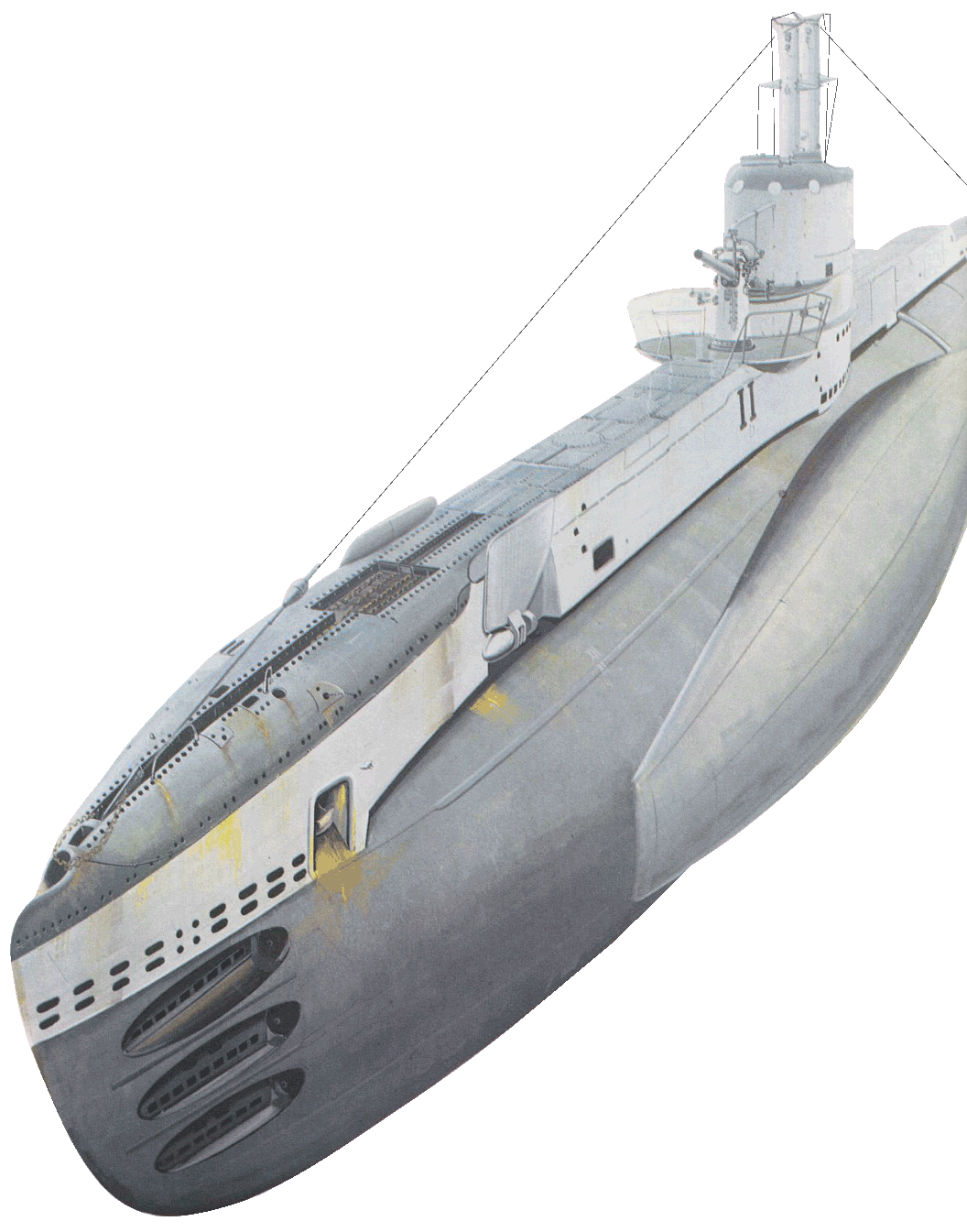
British Sealion. In 1929 the first orders were placed for medium-sized patrol submarines, as the Royal Navy became aware of the need for smaller boats to work in Northern European waters. The problem of leaking fuel tanks was solved by putting them inside the pressure hull, and as speed and submerged endurance were not sacrificed the "S" Class was most successful. An improved version was put into mass production during the Second World War, making this class the largest single group of submarines built for the Royal Navy: more than sixty units were built over a period of fifteen years. Displacement: 735 tons (full load, surfaced). Armament: Six 21-in torpedo-tubes (forward); one 3-in gun. Speed: 13,5 knots (surfaced), 10 knots (submerged)
By 1939 the Admiralty had ensured that some 200 escort vessels were fitted with Asdic, and all anti-submarine tactics had been developed to make use of its remarkable properties. It led, however, to a dangerous under-estimation of the threat from submarines, and there were people in the Admiralty who talked of the submarine being a weapon of the past. Not only were there too few escort vessels for the amount of shipping to be protected, but the Asdic had its blind spots; it could not be used against a surfaced submarine, and at that stage in its development it could not hold the target when the searching ship passed overhead. Thus an attack with depth - charges always had to be carried out "blind".
The aircraft had shown itself to be a dangerous enemy to submarines during the First World War, and the increased range of aircraft in 1939 made them far more dangerous. It was not foreseen that the ordinary aircraft bomb would be ineffective against submarines, and the lack of sufficient numbers would also prevent aircraft from making a full contribution at first, but ultimately they proved the submarine's worst enemy. Another less-publicised weapon which was available was the mine. In 1917/18 mines had accounted for 49 U-Boats, over a quarter of the total sunk, but for some reason the value of offensive mining against submarines was still disputed in 1939. Nevertheless, the Royal Navy had developed the magnetic mine which it had used in 1918, and had large stocks of an anti-submarine pattern in hand.
When war broke out between Britain, France and Germany on 3 September 1939, the German Navy had 56 U-Boats in commission, with five more nearing completion. Some 40 of these were already at their war stations around the British Isles, and despite the fact that Hitler's instructions forbade "unrestricted" warfare against merchant shipping, one of them sank the liner Athenia without warning on the first day of the war. Hitler's instructions were based on his reluctance to antagonise neutral opinion, but as early as 1937 the Admiralty had assumed that these restrictions would not be obeyed.
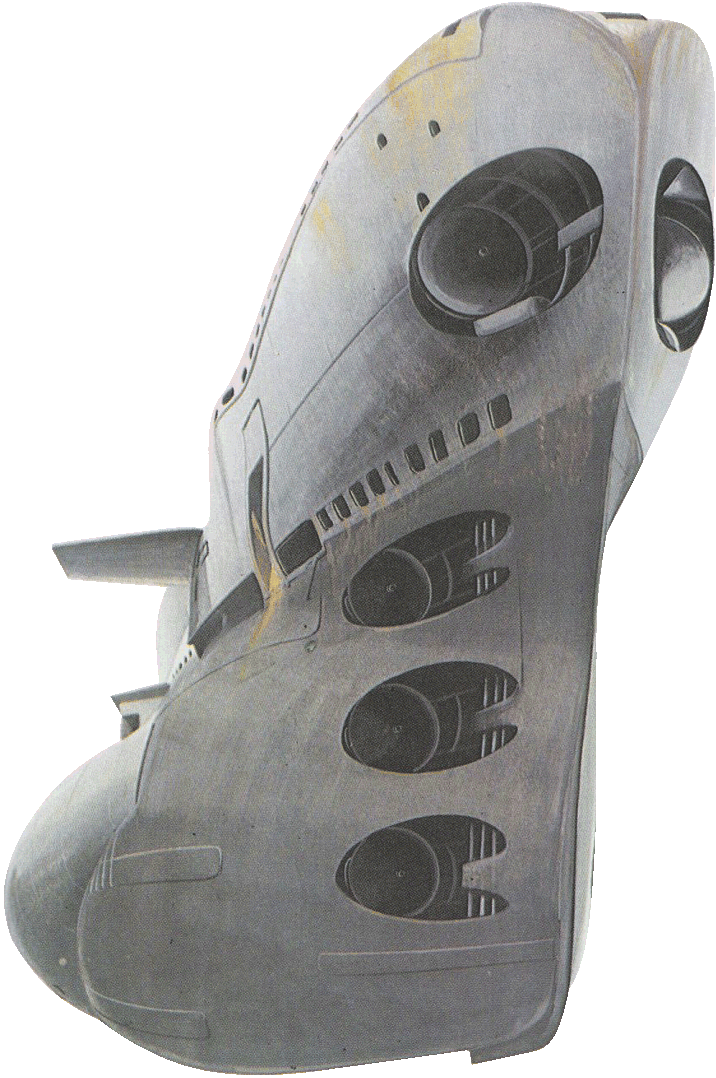
British Thrasher. The famous "T" Class were designed for overseas operations, and so size had to be increased to approximately 1,100 tons. They had the heavy armament of ten torpedo-tubes, eight in the bow and two aft. The two upper tubes were externally fitted, and could not be reloaded at sea. Displacement: 1,321 tons (full load, surfaced. Armament: Ten 21-in torpedo-tubes; one 4-in gun
The Athenia sinking was a genuine mistake, as the commander of U30 mistook her for a troop transport; other U-Boats behaved in a humane manner towards their victims in this early period of the war. It was known to the journalists as the "Phoney War", and some people talked of a sinister plot between the Allies and Hitler, but there was nothing phoney about the 199 merchant ships sunk by the end of March 1940. Nor had the U-Boats escaped lightly, as 18 had been sunk in the same period.
The U-Boats had also scored some notable successes against warships. Two weeks after the outbreak of war the aircraft carrier Ark Royal was attacked by U39, but the carrier's escorting destroyers pounced and sank her. Three days later, however, another carrier, HMS Courageous, was sunk by U29, and on 14 October U47 brought off a brilliant coup by sinking the battleship Royal Oak in her supposedly secure base at Scapa Flow. Kapitän-Leutnant Prien took his U-Boat in through the tortuous channels past the rusting blockships which had lain there since 1914, and finally found the battleship at anchor. After one salvo of torpedoes missed, Prien reloaded and fired a spread of three which detonated under the Royal Oak's keel; she capsized and sank with 833 of her crew.
The Royal Oak was an elderly second-line unit whose loss could hardly rank with that of the carrier Courageous in military value, but U47's exploit had far more impact. The realisation that Scapa Flow could be penetrated by a submarine forced the British to remove their entire Home Fleet to a series of temporary anchorages, just as the Grand Fleet had gone a-wandering in 1914 after a submarine scare. At a crucial moment the whole British strategy for penning the German Navy's surface warships in the North Sea, had been drastically changed, all by one submariner and his crew's determination and courage.
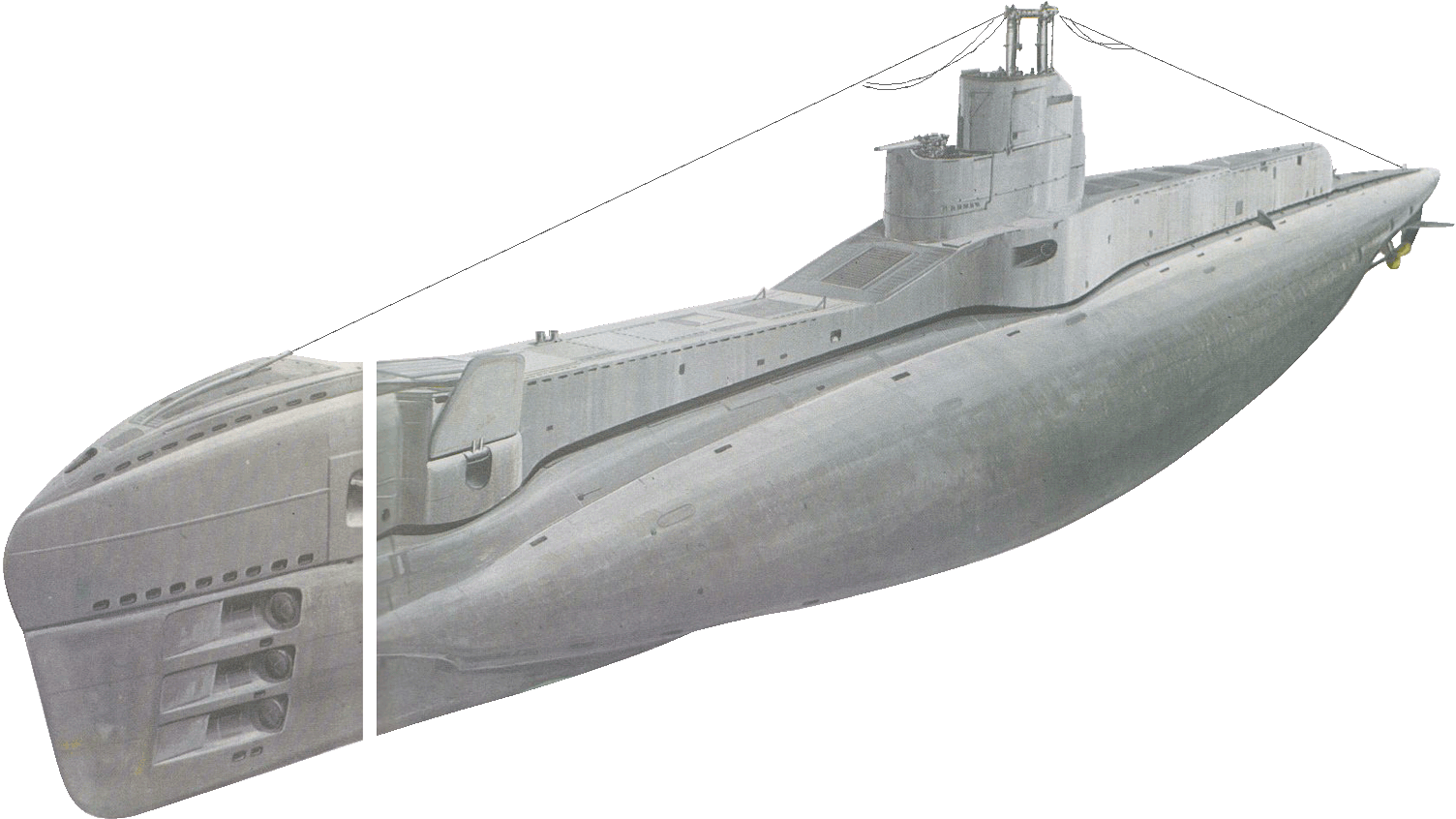
British Thunderbolt. This member of the "T" Class was far better known as the Thetis after being lost in a tragic accident in Liverpool Bay in June 1939. To avoid any suggestion of a jinx on the boat the Admiralty put her into service under a new name, but this did not stop her from being sunk by an Italian corvette north of Sicily in 1943. Despite the Thetis disaster, the "T" Class had a high reputation for reliability, and fifty-five were built between 1937 and 1945
Only 38 British submarines were available in September 1939, and although the British blockade of the North Sea denied them any big opportunities for attacking German shipping, they had an important role to play. They were immediately deployed to extend air patrol lines, in order to give warning of enemy naval movements, and to harass U-Boats and surface warships in their home waters. What was not realised for some time, however, was that a policy of sending submarines to lie off enemy bases would expose the submarines to a high loss rate. This is because a base acts like a convoy - in fact a convoy with a reduced perimeter - and thus the advantage swings to the enemy's anti-submarine forces.
In April and May 1940 there was a sudden lull in U-Boat activity, and only 20 ships were sunk; this was because Admiral Dönitz had recalled most of his boats to regroup for the invasion of Norway. The British also had plans for Norway, as they wanted to lay minefields to interrupt the iron-ore traffic from Narvik to Germany. After the end of the campaign only submarine minelayers could be used, and to strengthen the effort the Admiralty persuaded the French Government to lend them the Rubis. This famous submarine laid her first mines off Christiansand on 10 May 1940. the first episode in a career which lasted until 1944 and accounted for 15 merchant ships and seven warships sunk, and a merchant ship and a U-Boat damaged.
British Upholder. The first three "U" Class were ordered in 1936 to serve as unarmed targets for antisubmarine vessels, but they were completed with torpedo-tubes to allow them to carry out normal submarine training as well. In 1940 it was realised that their small size suited them for the North Sea and Mediterranean, and so they were put into quantity production. HMS Upholder was commanded by Lt Cdr Wanklyn VC, and she sank over 90,000 tons of German and Italian shipping in the Mediterranean before she was herself sunk in April 1942. Displacement: 648 tons (full load, surfaced). Armament: Four 21-in torpedo-tubes; one 3-in AA gun. Speed: 11¾ knots (surfaced), 9 knots (submerged)
The increased German naval activity in the Norwegian campaign gave Allied submarines much greater opportunities for attacking. The Polish Orzel sank a large troopship, the Spearfish damaged the pocket battleship Lützow severely, and the Sunfish sank four ships, among others. Later the Clyde inflicted heavy damage on the battle cruiser Gneisenau. These casualties, when combined with the depredations caused by surface action, were sufficient to reduce the Kriegsmarine's strength below the level needed to support the invasion of England planned after Dunkirk. Once more the submarine had intervened decisively in the conduct of war at sea; and had exerted an influence beyond all proportion to her size and cost.
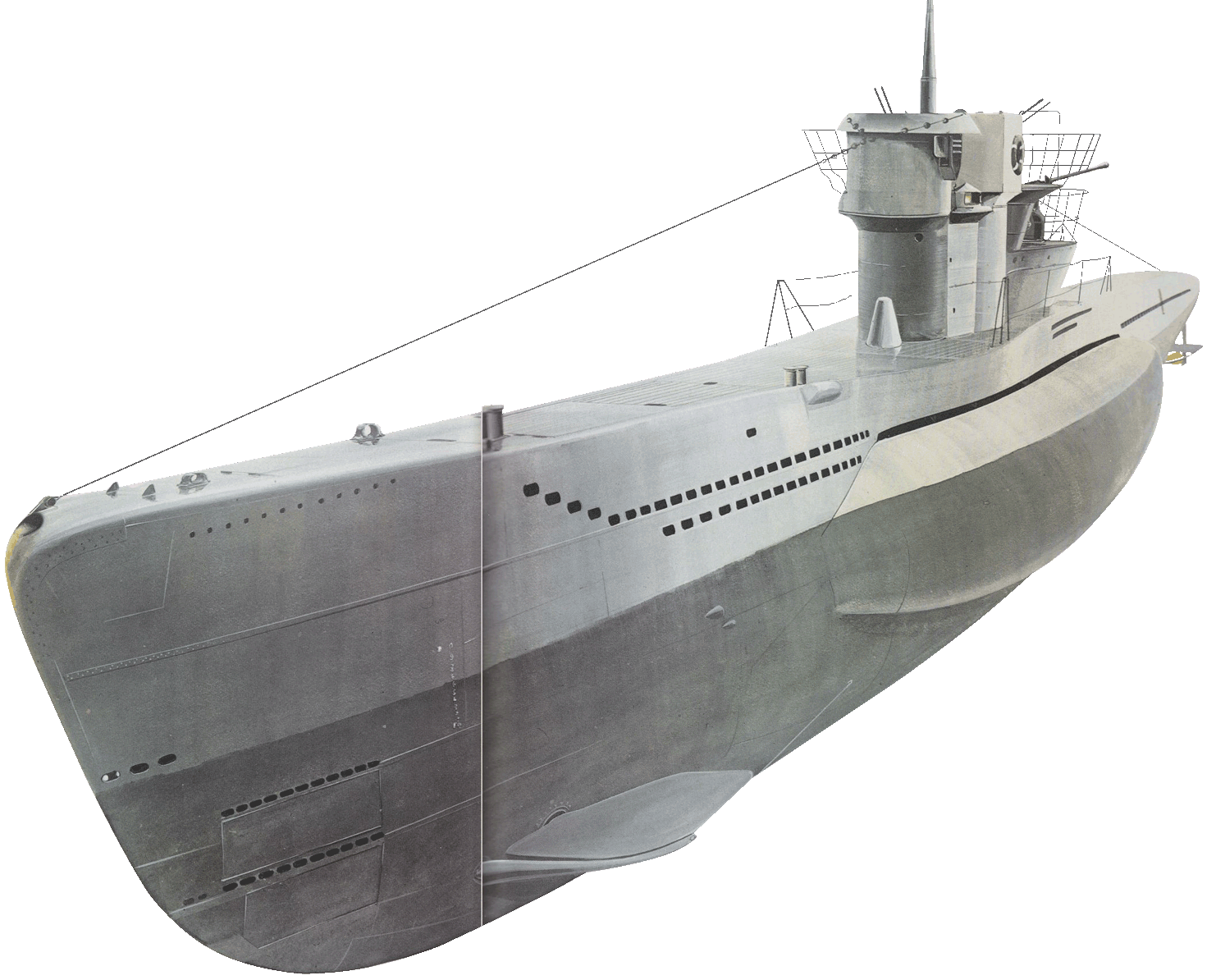
German Type VII (U236). The Type VII U-Boat was the standard design for the U-Boat in the Second World War. It was developed from the Finnish Vetehinen design before the expiry of the Versailles Treaty, and many improvements were effected as a result of war experience. U236 was one of the Type VIIC, the third version, and she came into service in January 1943. She was scuttled in 1945 after suffering damage by air attack. Displacement: 769 tons (surfaced). Armament: Five 21-in torpedo-tubes; 14 torpedoes carried; plus a variety of light AA guns. Speed: 17 knots (surfaced), 7,5 knots (submerged)
In one respect the British had been extremely lucky throughout this first phase of submarine warfare; whereas their own torpedoes were reliable the Germans' magnetic pistols had proved to be uncertain.
An estimated 30 attacks by U-Boats against British ships during the Spring of 1940 yielded only the submarine Thistle to U4 off Skudesnes. Both the British and the Germans had been experimenting with magnetic pistols for torpedo warheads before 1939, the advantage being that a torpedo exploding beneath the keel of a large warship would do far more damage than it could by exploding against its side.

British Telemachus. Like the German Type VII the British "T" Class went through many wartime modifications. This example shows how many changes had been made in the original design: a changed bow shape, external tubes now facing aft, and a platform on the conning tower for a 20-mm AA gun. She was completed in 1943 and scrapped in 1961
New weapons often create their own antidote, and so it happened in this case that a process called "degaussing" was immediately introduced to reduce a ship's magnetism. This could be met by increasing the sensitivity of the magnetic pistol, but the pistol was then liable to interference from the Earth's magnetic field, with the result that a deep-running torpedo might explode either prematurely or not at all.
Conforming to the well-known tendency for military and naval tactics to move in circles, the Royal Air Force matched the failure of German torpedoes by dropping bombs which did not sink U-Boats. Pre-war practice had made airmen over-optimistic about the accuracy of bombing runs against submarines, and also about the value of the conventional bomb. A bomb needs a direct hit, which is hard to achieve against the small, slender target presented by a submarine, whereas a near miss from a depth-charge can inflict vital damage to the hull. The answer to the problem was simple; the Mark VII naval pattern depth-charge was modified to make it more suitable for dropping from aircraft and came into service before the end of 1940. Later, however, properly designed airborne depth-charges were produced.
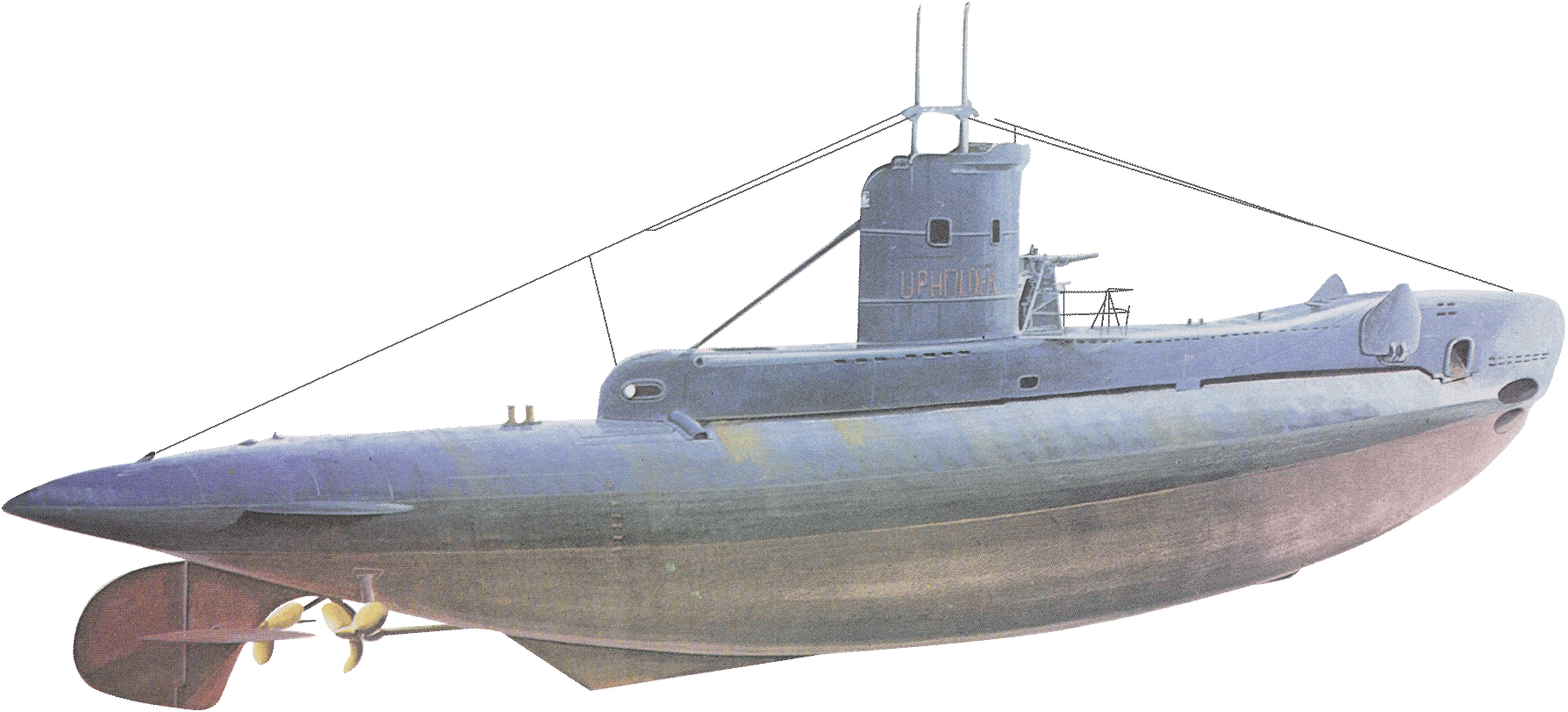

German Type IXB. These ocean-going boats were developed from the UEII Type of the First-World War, and had more endurance than the Type VII series. They proved less suitable for the Western Approaches and were used in distant waters, but their average of tonnage sunk was as high as any other group of U-Boats. Their main drawback was that they took too long to build, and only 14 were built. Displacement: 1,051 tons (surfaced). Armament: Six 21-in torpedo-tubes; 22 torpedoes carried; one 105-mm gun; one 37-mm gun; one 20-mm gun Speed: 18¼ knots (surfaced), 7¼ knots (submerged)
The collapse of France brought about a tremendous change in the naval situation, quite apart from the threat posed by German hopes of invading the British Isles. For a start, the loss or immobilisation of almost the entire French Fleet threw the whole burden of protecting shipping on the Royal Navy. Then the entry of Italy into the war as a partner of Germany meant that British ship-movements in the Mediterranean would be menaced by over 100 Italian submarines, in addition to whatever number of U-Boats could be spared from the Atlantic. A third factor was the greatly increased number of U-Boat bases available.
We have much more interesting information on this site.
Click MENU to check it out!
∎ cartalana.com© 2009-2025 ∎ mailto: cartalana@cartalana.com